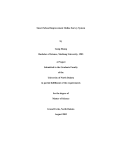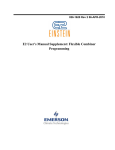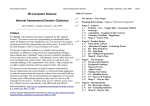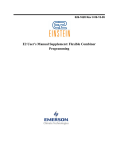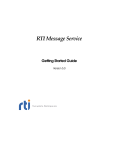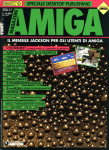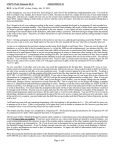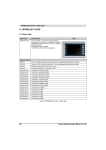Download A1: Analysis of the Problem
Transcript
Table of Contents
A1: Analysis of the Problem................................................. 1
Introduction .................................................................................................................. 1
Problem ......................................................................................................................... 1
Past Solutions ............................................................................................................... 1
End-User ....................................................................................................................... 2
End-User Questions..................................................................................................... 2
End-User Requirements for System.......................................................................... 3
Input............................................................................................................................... 3
Output............................................................................................................................ 3
Interfaces/Sub-Programs............................................................................................ 3
User Action Flow Chart ............................................................................................... 4
A2: Criteria for Success....................................................... 5
Introduction .................................................................................................................. 5
Behavior Outline .......................................................................................................... 5
Objectives ...................................................................................................................... 5
Goals............................................................................................................................... 5
Environment Requirements/Operating Restrictions ............................................. 5
A3: Prototype Solution........................................................ 6
Design/User-Action Flow Chart................................................................................. 6
User Feedback .............................................................................................................. 8
B1: Data Structures ............................................................. 9
B2: Algorithms...................................................................13
B3: Modular Organization ................................................ 18
C1: Code & Good Programming Style .................................21
AvtivityNode.java ....................................................................................................... 21
Activity.java................................................................................................................. 21
ActivityLL.java............................................................................................................ 24
CalendarL.java............................................................................................................ 29
CalendarMain.java ..................................................................................................... 32
C2: Usability...................................................................... 45
C3: Handling Errors.......................................................... 46
C4: Success of Program..................................................... 47
D1: Test Output (Annotated Hard Copy) ........................... 48
D2: Evaluation of Solution ................................................ 54
D3: User Documentation (User Manual)........................... 56
Installation .................................................................................................................. 56
Add Activity................................................................................................................. 56
Remove Activity............................................................................................................. 58
Find Activity .................................................................................................................. 59
Print Calendar............................................................................................................. 60
Quit Calendar................................................................................................................. 61
Mastery Aspects ................................................................ 62
Suchana Costa
Calendar Database
A1: Analysis of the Problem
Introduction
Organization is a key part of success for individuals and businesses alike. Good
organization involves good time management, planning, keeping track of events and tasks,
and having necessary tools and information easily accessible. An inability to meet these
requirements can have detrimental side effects. Poor time management and planning can
waste valuable time. The lack of control over plans may cause chronic tardiness. Not
having easy access to the equipment and data needed to complete tasks can cause low
productivity. The overall result of disorganization is stress and an inability to meet goals.
Problem
The underlying problem that causes disorganization is the misplacement of objects
and facts. A small misplacement of a phone number or failure to recall important dates can
morph into bigger losses. Scattering information, like a phone number, as noted above,
includes wasting time in the search, the potential loss of a contact, and a sense of frustration
and powerlessness. If such misplacement and incompetence can be reduced, disorganization
may be eliminated.
A system of organization may increase punctuality, efficiency, and productivity.
Individuals, ranging from students to professionals, could use a quick and simple way to
keep track of their schedules. When all information, such as appointments, can be available,
it becomes easier to gauge the amount of time available for new activities and work around
important dates.
Past Solutions
In attempts to maintain order, people have turned to their memories, calendars, and
planners. The use of memory fluctuates in effectiveness and does not work for everyone, as
people have different capacities to recall important details. Generally, reliance on memory
slows people down, especially when the amount needed to be noted increases. Calendars
and planners work well to an extent. Calendars allow people to visualize their time, but only
provide a snapshot, as multiple events and details usually cannot be recorded under the same
day. Planners can provide more room and include calendars for snapshots of longer time
periods. Both calendars and planners may be difficult to edit because changes require
erasing, rewriting, and crossing out. If they are physically damaged or misplaced, the
information contained in them may be very difficult to recover. Electronic calendars and
planners exist, which reduces the chances of losing information and allows for changes to be
made more easily.
A system of organization and keeping up with activities and events should take
various details of the activity and time it will occur. The database should allow all aspects of
an activity to be recorded and searched so they can be easily found in one location.
1
Suchana Costa
Calendar Database
The above picture is an example of an existing paper planner or calendar which records dates and activities.
End-User
End-User: The end-user will be students and professionals who would like to use an
electronic calendar database to keep track of events and activities.
End-User Questions
• What events or activities are you involved in?
• Who else is participating in the events and/or activities?
• How would you prioritize your activities in order of importance?
• When does your schedule encounter the most conflicts?
• What calculations do you need?
• Do you need to make changes to your schedule?
• Do you need file I/O?
• How far ahead do you need to plan for?
2
Suchana Costa
Calendar Database
End-User Requirements for System
• Able to perform quick searches
• Able to edit and save information
• Searchable by attributes
• User friendly
• Able to track activities and times
• Can detect time conflicts
Input
• Activity/Event Name
• Month of Activity
• Date of Activity
• Time
• Location
• People Involved
• Notes/Description
• Priority Value (1 being least important, 5 being most important)
Output
• Activity Information (name, date, time, location, people, notes, etc)
• Conflicts within Activities
• Options to Resolve Potential Conflicts
• List of Activities that Match Search
Interfaces/Sub-Programs
• Display specific activity information (name, date, time, location, people, notes, etc)
• Display specific dates
• Search for activities by name, date, location
• Add or remove activities
• Edit/change information
• Normal user interface
3
Suchana Costa
Calendar Database
User Action Flow Chart
What would you like to do?
Add
Activity
Remove
Activity
Enter
Details
Enter Activity
Name & Month
Activity
has been
added
Display
Activity
Matches
Quit
Activity
Exits
Menu
Search
Calendar
Enter Attribute
to Compare
View
Calendar
Display all
Activities in
chronological
order
Display
Activity
Matches
Select
Activity to
Remove
4
Suchana Costa
Calendar Database
A2: Criteria for Success
Introduction
This section will outline and list the objectives of an electronic calendar system and
how it will function. It will describe how users will apply the functions of the system and
database.
Behavior Outline
• Allow users to perform quick searches
• Allow users to add/remove entries
• Display previously entered data
• Search database using different categories (name, location, etc)
• Organize data chronologically
• Have user-friendly menus
Objectives
• Conduct quick searches
- This will allow users to locate information efficiently, saving time and energy.
• Store and display data in chronological order
- This will allow users to easily visualize and organize their time.
• User-friendly menus
- This will allow users to easily manipulate the database, reducing stress.
• Easily add/remove
- This will allow users to manipulate the calendar without ruining the aesthetic
appeal or order of it.
Goals
• Efficient searches
• Easy to follow interfaces
• Input error detection concerning dates and times
• File Input/Output
Environment Requirements/Operating Restrictions
• Can be run on PC
• Terminal
• Lots of hard drive space for searches and storing data
• Printers may be used to obtain hard copies of calendars
5
Suchana Costa
Calendar Database
A3: Prototype Solution
Design/User-Action Flow Chart
Select Action
Add
Activity
Enter
Activity
Name,
Month,
Date,
Start
time,
Notes
Remove
Activity
Quit Menu
Enter
Activity
Name &
Month
Search
Calendar
View
Calendar
Select
Attribute
to
Compare
Select
Activity
from
Matches
to Delete
Welcome!
Select Action
What would you like to do?
a) Add Activity
b) Remove Activity
c) Search Calendar
d) View Calendar
e) Quit
Enter choice: a_
Add New Activity
Activity Name: Soccer Practice_
Month: March_
Date: 22_
Start Time: 4:00 PM_
Location: Quincy Field_
Notes: ________
Add
Activity
6
Suchana Costa
Calendar Database
Select Action
Welcome!
What would you like to do?
a) Add Activity
b) Remove Activity
c) Search Calendar
d) View Calendar
e) Quit
Enter choice: b_
Remove Activity
Please enter….
Activity Name: Soccer Practice
Month: March
Enter
Activity
Name &
Month
Select
Activity
from
Matches
to Delete
Select Activity to Delete from Matches
Activity Matches….
2
Activity Name: Dinner
Month: March_
Date: 25
Start Time: 5:00
Location: Restaurant_
1
Activity Name: Soccer
Month: March_
Date: 22_
Start Time: 4:00
Location: Quincy Field_
Enter choice:___
Welcome!
Select Action
What would you like to do?
a) Add Activity
b) Remove Activity
c) Search Calendar
d) View Calendar
e) Quit
Enter choice: c_
7
Suchana Costa
Calendar Database
Search:
Which attribute do you want to compare?
a) name
b) date
c) location
d)
Select
Attribute
to
Compare
Enter choice: __
Enter attribute:__________
Welcome!
What would you like to do?
a) Add Activity
b) Remove Activity
c) Search Calendar
d) View Calendar
Enter choice: d_
Calendar:
Activity Name: Soccer
Month: March_
Date: 22_
Start Time: 4:00
Location: Quincy Field_
Activity Name: Dentist
Month: March_
Date: 25
Start Time: 3:00
Location: Office_
User Feedback
• Can arrow keys be used?
• Could be tedious to type in month
• Would users really want to see only month?
• Can there be scroll down menus?
8
Suchana Costa
Calendar Database
B1: Data Structures
Activity
An activity will contain all information related to and an activity, including its name,
time, location, and any extra notes regarding it.
Example:
String
Int
Int
Int
Int
String
String
Activity Name: Dentist
Month: 4
Date: 5
Start Time hour: 8
Start Time min: 05
Location: Dentist Office
Notes: Bring insurance information
This information can be used to compare in searches. The user can select an
attribute to use to locate a specific activity. More activities may be added and previously
entered activities may be removed as well.
Calendar
The calendar will be the main data structure that stores all activities. The activities
will be stored in a linked list by date and binary tree by time. This will allow the activities to
be easily sorted, compared, and searched.
Example:
January (1)
1
1:00 -Lunch
3:00 - New Years Picnic
2
6:00 - Run
3
This example shows three days of a month stored in Calendar.
Linked List
The activities will be stored in a linked list by date (month and day). When a search
is being conducted or the data is being sorted, the linked list would be used to sort through
the months and dates. The right day can be located, narrowing down the search for the
activity.
The alternative to a linked list could be an array for each month and day. Arrays
were avoided because they are static and it is easier to add data to linked lists.
Comparing Activities
When a user wants to find an activity or remove an activity the user uses specific
attributes of the activities to compare. The activities are stored in a linked list by date
because it is easiest to use when everything must be accessed. It allows for repetition and is
easy to remove from a linked list.
Comparisons can be made based on name, date, and location.
9
Suchana Costa
Calendar Database
Activities are stored in a linked list for comparisons based on name, date, and location.
Example of Add to an Empty List:
Before:
To be added:
After:
10
Suchana Costa
Calendar Database
Example of Add to a non empty list:
Before:
To be added:
null
After:
11
Suchana Costa
Calendar Database
Example of Remove from a non empty list:
Before:
To be removed:
After:
12
Suchana Costa
Calendar Database
B2: Algorithms
Name
Description
Parameters
Return Value
Pre-Conditions
Post-Conditions
Pseudo code
add
Adds an activity and its information into the Calendar.
• String name
• int month
• int day
• int startTime
• int endTime;
• String location
• String notes
none
The calendar may or may not be empty.
A new activity has been added to the calendar
1) Prompt user for attributes
2) Add activity to end of linked list
3) Once date match has been found, compare start times and end times
of activities
4) If start time of new activity falls within start and end time of an
activity already in the calendar, return both activities’ information
5) Prompt user for his/her choice on how to resolve conflict (delete new
activity, delete old activity, change start time of new activity)
13
Suchana Costa
Calendar Database
Name
Description
Parameters
Return Value
Pre-Conditions
Post-Conditions
Pseudo code
Name
Description
Parameters
Return Value
Pre-Conditions
Post-Conditions
Pseudo code
findName
Finds matches based on the activity name.
String name
String toString
The calendar is not empty.
Matches have been found based on name.
1) Check to see if calendar is empty
2) Search through lists and activity names
3) Display list of all activities their corresponding information that
match the name
findLocation
Finds matches based on the date the activity is scheduled for.
String Location
String toString
Matches have been found based on date.
An activity has been removed from the calendar
1) Check to see if calendar is empty
2) Search through lists and activity locations.
3) Display list of all activities their corresponding information that
match the date.
14
Suchana Costa
Calendar Database
Name
Description
Parameters
Return Value
Pre-Conditions
Post-Conditions
Pseudo code
Name
Description
Parameters
Return Value
Pre-Conditions
Post-Conditions
Pseudo code
findDate
Finds matches based on the date the activity is scheduled for.
• int month
• int day
String toString
Matches have been found based on date.
An activity has been removed from the calendar
1) Check to see if calendar is empty
2) Search through lists and activity months and days.
3) Display list of all activities their corresponding information that date..
print
Edits information in an activity.
none
String toString
The calendar is not empty.
Activities are displayed.
1) Check to see if calendar is empty
2) Prompt user for month or all
3) Traverse through the lists for all activities that match the month and
date, and return the activities’ information.
15
Suchana Costa
Calendar Database
Name
Description
Parameters
Return Value
Pre-Conditions
Post-Conditions
Pseudo code
selectionSort
Sorts activities in order by month and date.
none
void
The calendar is not empty.
Activities are sorted by month, date, and start time.
1) Check to see if calendar is empty
2) Compare months, if one is less than another, then switch them.
3) Traverse through the activities and compare dates, if one is less than
another, then switch them.
16
Suchana Costa
Calendar Database
Name
remove
Description
Removes an activity from the Calendar.
Parameters
String name
Return Value
none
Pre-Conditions
The calendar is not empty.
Post-Conditions
An activity has been removed from the calendar
1) Check to see if calendar is empty
2) Prompts user for activity name
3) Searches through the list for activity name
4) Once a match has been found, the activity is removed from the list
Pseudo code
17
Suchana Costa
Calendar Database
B3: Modular Organization
⇒ class CalendarMain
⇒ public static void remove
class Calendar
• class ActivityLL
class ActivityNode
• class Activity
⇒ class CalendarMain
⇒ public static void add
class Calendar
• class ActivityLL
class ActivityNode
• class Activity
⇒ class CalendarMain
⇒ public static void print
class Calendar
• class ActivityLL
class ActivityNode
• class Activity
⇒ class CalendarMain
⇒ public static void find
class Calendar
• class ActivityLL
class ActivityNode
• class Activity
18
Suchana Costa
Calendar Database
class CalendarMain: The CalendarMain consists of a menu, which asks the user which
function she/he would like to run. They may add an activity, find an activity, remove an
activity, change an activity, or print activities. Once a choice has been made, it goes to the
submenu of the function the user chose.
static void add: This method adds activities to the ActivityLL. It prompts the user
to for attributes (i.e. name, location, date, month, etc). The Activity is then added to
the ActivityLL.
static void find: This method searches through the ActivityLL to find an activity. It
prompts the user for known information (i.e. date and month, location, name, etc)
and traverses through ActivityLL to find matches.
static void remove: This method removes activities from the ActivityLL. It prompts
the user an activity name, searches through the ActivityLL for the matching activity,
then removes the first matching activity from the linked list.
static void print:: The print method prints out all of the activities in ActivityLL.
class ActivityLL: The ActivityLL is a linked list that holds all of the entered activities. A
linked list is the easiest structure because it allows for dynamic size.
isEmpty: Checks to see of the ActivityLL is empty (empty of size = 0)
add: Adds an ActivityNode to the end of the list
remove: Removes an ActivityNode from the list
selectionSort: Sorts the ActivityNodes in order of month, date, and startTime
find: Compares attributes of all Activities and returns matches
print: Prints all ActivityNodes in order of month, date, and StartTime
class Activity: The Activity class is used to create and store an activity. It takes in different
data (i.e. month, date, startTime, location, name, notes) and has methods to “get” and “set”
the data. The “get” method accesses the information in the activity and is used for
comparisons. The “set” method is used to set or change information in the activity.
get: Returns the different attributes as strings and integers
set: sets different attributes
activity.setLocation(“Little Theater);
toString: Takes all of the attributes and puts them into one string for printing
print: prints all of the attributes
class ActivityNode: Creates anode that stores an Activity and points to the next Activity in
ActivityLL
class CalendarL: The Calendar stores the linked list of activities and allows all of the
functions to be used.
19
Suchana Costa
Calendar Database
static void find: This method sesarches through the ActivityLL to look at the
information for each Activity. It can find any activity using different attributes
attribute.
static void add: The add method is used to add activities to the ActivityLL.
static void remove: The remove method is used to remove activities from the
ActivityLL.
static void print: The print method prints out all of the activities in ActivityLL or
just one activity, depending on the user’s choice.
20
Suchana Costa
Calendar Database
C1: Code & Good Programming Style
AvtivityNode.java
/*
File Name: ActivityNode.java
Author: Suchana Costa
Date: February 2, 2010
School: Washington-Lee High School
Computer Used: Dell Optiplex GX620
IDE: GEdit
Purpose: Creates the Activity Node
*/
//ActivityNode Class
public class ActivityNode
{
public Activity myActivity = null;
public ActivityNode next = null;
// default constructor
public void ActivitytNode()
{
}
}
______________________________________
Activity.java
/*
File Name: Activity.java
Author: Suchana Costa
Date: February 2, 2010
School: Washington-Lee High School
Computer Used: Dell Optiplex GX620
IDE: GEdit
Purpose: Defines basic attributes for activity class
*/
public class Activity
{
//attributes
private String name = "";
private int month = 1;
private int date = 1;
private int startTimeh = 0;
private int startTimem = 0;
private String location = "";
private String notes = "";
21
Suchana Costa
Calendar Database
public Activity()
{
}
public Activity(String newName, int newMonth, int newDate, int newStartTimeh, int newStartTimem,
String newLocation, String newNotes)
{
name = newName;
month = newMonth;
date = newDate;
startTimeh = newStartTimeh;
startTimem = newStartTimem;
location = newLocation;
notes = newNotes;
}
//setters (mutators)
public void setActivityName(String newName)
{
name = newName;
}
public void setMonth(int newMonth)
{
month = newMonth;
}
public void setDate(int newDate)
{
date = newDate;
}
public void setStartTimeh(int newST)
{
startTimeh = newST;
}
public void setStartTimem (int newST)
{
startTimem = newST;
}
public void setLocation(String newL)
{
location = newL;
}
public void setNotes(String newNotes)
{
notes = newNotes;
}
//Accessors (getters)
public String getActivityName()
22
Suchana Costa
Calendar Database
{
}
return name;
public int getMonth()
{
return month;
}
public int getDate()
{
return date;
}
public int getStartTimeh()
{
return startTimeh;
}
public int getStartTimem()
{
return startTimem;
}
public String getLocation()
{
return location;
}
public String getNotes()
{
return notes;
}
public String toString()
{
return name + " is scheduled on " + month + "/" + date + ", " + "at hour:" + startTimeh
+ " and minute:" + startTimem + ", at " + location + ". " + "\n" + "Things to remember:" + "" + notes +
"\n"+ "\n";
}
}
23
Suchana Costa
Calendar Database
ActivityLL.java
/*
File Name: ActivityLL.java
Author: Suchana Costa
Date: February 2, 2010
School: Washington-Lee High School
Computer Used: Dell Optiplex GX620
IDE: GEdit
Purpose: Creates a Linked List to store data
*/
public class ActivityLL
{
//attributes
private ActivityNode head = null;
private ActivityNode tail = null;
private int size = 0;
//default constructor
public ActivityLL()
{
}
// isEmpty() returns true if the LinkedList is empty, and false otherwise
public boolean isEmpty()
{
return size == 0;
//return head == null;
}
//Add an Activity to the LinkedList (to the end of the list, not paying attention to order)
public boolean add(Activity newActivity)
{
if (isEmpty())
{
ActivityNode myNode = new ActivityNode();
myNode.myActivity = newActivity;
head = myNode;
tail = myNode;
size++;
return true;
}
//Add an Activity to the LinkedList (to a nonempty list)
if (!isEmpty())
{
ActivityNode myNode = new ActivityNode();
myNode.myActivity = newActivity;
tail.next = myNode;
tail = myNode;
size++;
return true;
}
24
Suchana Costa
Calendar Database
return false;
}
//Remove an Activity
public void Activity remove(String name)
{
//Cannot remove from an empty list
if (isEmpty())
{
return null;
}
//Remove an activity from a nonempty list
if (!isEmpty())
{
ActivityNode previous = head;
for (ActivityNode current=head; current !=null; current= current.next)
{
if(current.myActivity.getActivityName().equals(name))
{
//Set the previous node to the node after the current
and decrease size
previous.next = current.next;
size --;
}
}
previous = current;
}
}
///Find Activity by date
public int findDate(int date, int month)
{
int count = 0;
for (ActivityNode current=head; current != null; current= current.next)
{
//if the date and the month match, return the index (count)
if(current.myActivity.getDate() == date && current.myActivity.getMonth()==
month)
{
//System.out.print(current.myContact);
return count;
}
count ++;
}
return -1;
25
Suchana Costa
Calendar Database
}
//Find Activity by name by recursion
private int findName(String name, ActivityNode node, int count)
{
if (node == null)
return -1;
if (node.myActivity.getActivityName().equals(name))
return count;
return findName(name, node.next, count + 1);
}
//Find Activity by location
public int findLocation(String location)
{
int count = 0;
for (ActivityNode current=head; current !=null; current= current.next)
{
if(current.myActivity.getLocation().equals(location))
{
}
//System.out.print(current.myContact);
return count;
count ++;
}
}
return -1;
//Get the Activity you had searched for or get Activity at specific index
public Activity getActivity(int index)
{
int count = 0;
for(ActivityNode current = head; current !=null; current = current.next)
{
//if you are at the correct current, set the previous next to the current's nex
if (count == index)
{
return current.myActivity;
}
}
count ++;
return null;
}
26
Suchana Costa
Calendar Database
//get size
public int size()
{
return size;
}
//print whole calendar (traverses the linked list and prints out the Activity info (date, time, etc) in
each NOde
public void print()
{
for (ActivityNode current = head; current != null; current = current.next)
{
System.out.print(current.myActivity);
}
}
public void selectionSort()
{
ActivityNode minNode;
for (ActivityNode front = head; front != null; front = front.next)
{
minNode = front;
for (ActivityNode current = front; current !=null; current = current.next)
{
//Compare months to see which is the earlier occurying month
if ((minNode.myActivity.getMonth()<(current.myActivity.getMonth())))
{
//Compare dates to find the earlier occuring date
if(minNode.myActivity.getDate() <
current.myActivity.getDate())
{
minNode = current;
}
}
}
}
//swap
Activity temp = front.myActivity;
front.myActivity = minNode.myActivity;
minNode.myActivity = temp;
}
//to file
public void save(String filename)
{
//open file using filename
RandomAccessFile file = new RandomAccessFile(filename, "rw");
//write out to file the size
Int saveSize = size;
file.writeUTF(saveSize);
//traverse through LL and writeUTF
for (ActivityNode myNode = Cal.getHead(); myNode != null; myNode = myNode.next)
27
Suchana Costa
Calendar Database
{
}
file.writeUTF(myNode.myActivity.getActivityName());
file.writeUTF(myNode.myActivity.getMonth());
file.writeUTF(myNode.myActivity.getDate());
file.writeUTF(myNode.myActivity.getStartTimeh());
file.writeUTF(myNode.myActivity.getStartTimem());
file.writeUTF(myNode.myActivity.getLocation());
file.writeUTF(myNode.myActivity.getNotes());
file.close();
}
System.out.println("File saved under name " + filename);
public void load(String filename)
{
RandomAccessFile rfile = new RandomAccessFile(filename, "r");
//Notice the "r", opening the file for reading
String stringSizse = file.readUTF();
//Read the first string that was originally written to file
int inSize = Integer.parseInt(stringSize);
for (int x = 1; x <= intSize; x +=1)
{
newActivity = new Activity();
String loadName = file.readUTF(myNode.myActivity.getActivityName());
String loadMonth = file.readUTF(myNode.myActivity.getMonth());
int loadDate = file.readUTF(myNode.myActivity.getDate());
int loadStartTimeh = file.readUTF(myNode.myActivity.getStartTimeh());
int loadStartTimem = file.readUTF(myNode.myActivity.getStartTimeh());
String loadLocation = file.readUTF(myNode.myActivity.getLocation());
String loadNotes = file.readUTF(myNode.myActivity.getNotes());
newActivity.setName(loadName);
newActivity.setMonth(loadMonth);
newActivity.setDate(loadDate);
newActivity.setStartTimeh(loadStartTimeh);
newActivity.setStartTimem(loadStartTimem);
newActivity.setLocation(loadLocation);
newActivity.setNotes(loadNotes);
}
}
add(newActivity);
file.close();
System.out.println("File has been loaded");
28
Suchana Costa
Calendar Database
CalendarL.java
/*
File Name: CalendarL.java
Author: Suchana Costa
Date: February 2, 2010
School: Washington-Lee High School
Computer Used: Dell Optiplex GX620
IDE: GEdit
Purpose: Defines functions for the Database 'Calendar'
*/
public class CalendarL
{
// attributes
private ActivityLL myActivityList = new ActivityLL();
private int size = 0;
// default constructor
public CalendarL()
{
}
//setters
public void setMyActivityArray(ActivityLL newMyActivityList)
{
myActivityList = newMyActivityList;
}
//sets size
public void setSize(int newSize)
{
size = newSize;
}
//getters
public ActivityLL getMyActivityList()
{
return myActivityList;
}
public int size()
{
return myActivityList.size();
}
public void add(Activity newActivity)
{
myActivityList.add(newActivity);
}
public void print()
{
myActivityList.print();
29
Suchana Costa
Calendar Database
}
public void selectionSort()
{
myActivityList.selectionSort();
}
//Find Activity from name
public Activity findName(String name)
{
int result = myActivityList.find(name);
//check if found
if (result != -1)
{
return myActivityList.getActivity(result);
}
}
return null;
//Find Activity from date
public Activity findDate(int d, int m)
{
int result = myActivityList.find(m, d);
//check if found
if (result != -1)
{
return myActivityList.getActivity(result);
}
return null;
}
//Find Activity from location
public Activity findLocation(String location)
{
int result = myActivityList.find(location);
//check if found
if (result != -1)
{
return myActivityList.getActivity(result);
}
}
return null;
//Find Activity by date
public String findDate(int date)
{
int count = 0;
//Traverses the LL for the first matching activity by date
for (ActivityNode current=head; current !=null; current= current.next)
{
if(current.myActivity.getDate() == date)
{
30
Suchana Costa
Calendar Database
}
//System.out.print(current.myContact);
return current.myActivity.toString();
}
return null;
}
//Find Activity by name
public String findName(String name)
{
int count = 0;
//Traverses the LL to find the first match by name
for (ActivityNode current=head; current !=null; current= current.next)
{
if(current.myActivity.getActivityName().equals(name))
{
//System.out.print(current.myContact);
return current.myActivity.toString();
}
}
return null;
}
//Find Activity by location
public String findLocation(String location)
{
int count = 0;
//Traverses through the LL to find the first match of location
for (ActivityNode current=head; current !=null; current= current.next)
{
if(current.myActivity.getLocation().equals(location))
{
//System.out.print(current.myContact);
return current.myActivity.toString();
}
}
}
}
return null;
public void print()
{
//Traverses through the LL and prints out each Activity
for (ActivityNode current = head; current != null; current = current.next)
{
System.out.print(current.myActivity);
}
}
31
Suchana Costa
Calendar Database
CalendarMain.java
/*
File Name: CalendarMain.java
Author: Suchana Costa
Date: February 2, 2010
School: Washington-Lee High School
Computer Used: Dell Optiplex GX620
IDE: GEdit
Purpose: Provides a menu for users to choose actions from
*/
import java.io.*;
public class CalendarMain
{
private static BufferedReader stdin =
new BufferedReader( new InputStreamReader( System.in ) );
public static void main ( String [] args ) throws IOException
{
ActivityLL Cal = new ActivityLL();
for(;;)
{
Activity a = new Activity();
//Prints out the main menu for users to choose action
System.out.println();
System.out.println("The Calendar is Open");
System.out.println();
System.out.println("Select what you would like to do:");
System.out.println();
System.out.println("(a)dd activity");
System.out.println("(r)emove activity");
System.out.println("(f)ind activity");
System.out.println("(p)rint Calendar");
System.out.println("(q)quit");
System.out.println();
System.out.println();
System.out.print("Enter choice:");
String answer = stdin.readLine();
if (answer.equals("a"))
32
Suchana Costa
Calendar Database
{
System.out.println("User selected ADD");
System.out.println();
System.out.print("Enter Activity Name:");
String name = stdin.readLine();
a.setActivityName(name);
//Checks to see if the input was an integer, and if not,
prompts the user to reenter teh data
int month = getCheckedInt("Please enter month (example:
If month is December, enter 12): ");
//Checks to make sure month is within the acceptable range
of 0 to 13
while (true)
{
while (month <= 0 || month >= 13)
{
int month1 = getCheckedInt("Please enter
month (example: If month is December, enter 12): ");
month = month1;
}
//The following if statements print out what the user
has selected and asks the user to verify whether or not their choice is correct
//If the user made a mistakem, the user may reenter
the month
if ( month == 1)
{
System.out.println("You chose January");
System.out.println("Is this correct? (y/n)");
String m1 = stdin.readLine();
if ( m1.equals("y") || m1.equals("Y") ||
m1.equals("yes") || m1.equals("YES"))
{
System.out.println("Month =>
January");
break;
}
else
{
month = 13;
33
Suchana Costa
Calendar Database
continue;
}
}
else if ( month == 2)
{
System.out.println("You chose February");
System.out.println("Is this correct? (y/n)");
String m1 = stdin.readLine();
if ( m1.equals("y") || m1.equals("Y") ||
m1.equals("yes") || m1.equals("YES"))
{
System.out.println("Month =>
February");
break;
}
else
{
month = 13;
continue;
}
}
else if ( month == 3)
{
System.out.println("You chose March");
System.out.println("Is this correct? (y/n)");
String m1 = stdin.readLine();
if ( m1.equals("y") || m1.equals("Y") ||
m1.equals("yes") || m1.equals("YES"))
{
System.out.println("Month =>
March");
break;
}
else
34
Suchana Costa
Calendar Database
{
month = 13;
continue;
}
}
else if ( month == 4)
{
System.out.println("You chose April");
System.out.println("Is this correct? (y/n)");
String m1 = stdin.readLine();
if ( m1.equals("y") || m1.equals("Y") ||
m1.equals("yes") || m1.equals("YES"))
{
System.out.println("Month =>
April");
break;
}
else
{
month = 13;
continue;
}
}
else if ( month == 5)
{
System.out.println("You chose May");
System.out.println("Is this correct? (y/n)");
String m1 = stdin.readLine();
if ( m1.equals("y") || m1.equals("Y") ||
m1.equals("yes") || m1.equals("YES"))
{
System.out.println("Month =>
May");
break;
}
else
{
35
Suchana Costa
Calendar Database
month = 13;
continue;
}
}
else if ( month == 6)
{
System.out.println("You chose June.");
System.out.println("Is this correct? (y/n)");
String m1 = stdin.readLine();
if ( m1.equals("y") || m1.equals("Y") ||
m1.equals("yes") || m1.equals("YES"))
{
System.out.println("Month =>
June");
break;
}
else
{
month = 13;
continue;
}
}
else if ( month == 7)
{
System.out.println("You chose July");
System.out.println("Is this correct? (y/n)");
String m1 = stdin.readLine();
if ( m1.equals("y") || m1.equals("Y") ||
m1.equals("yes") || m1.equals("YES"))
{
System.out.println("Month =>
July");
break;
}
else
36
Suchana Costa
Calendar Database
{
month = 13;
continue;
}
}
else if ( month == 8)
{
System.out.println("You chose August");
System.out.println("Is this correct? (y/n)");
String m1 = stdin.readLine();
if ( m1.equals("y") || m1.equals("Y") ||
m1.equals("yes") || m1.equals("YES"))
{
System.out.println("Month =>
August");
break;
}
else
{
month = 13;
continue;
}
}
else if ( month == 9)
{
System.out.println("You chose September");
System.out.println("Is this correct? (y/n)");
String m1 = stdin.readLine();
if ( m1.equals("y") || m1.equals("Y") ||
m1.equals("yes") || m1.equals("YES"))
{
System.out.println("Month =>
September");
break;
}
37
Suchana Costa
Calendar Database
else
{
month = 13;
continue;
}
}
else if ( month == 10)
{
System.out.println("You chose October");
System.out.println("Is this correct? (y/n)");
String m1 = stdin.readLine();
if ( m1.equals("y") || m1.equals("Y") ||
m1.equals("yes") || m1.equals("YES"))
{
System.out.println("Month =>
October");
break;
}
else
{
month = 13;
continue;
}
}
else if ( month == 11)
{
System.out.println("You chose November");
System.out.println("Is this correct? (y/n)");
String m1 = stdin.readLine();
if ( m1.equals("y") || m1.equals("Y") ||
m1.equals("yes") || m1.equals("YES"))
{
System.out.println("Month =>
November");
break;
38
Suchana Costa
Calendar Database
}
else
{
month = 13;
continue;
}
}
else if ( month == 12)
{
System.out.println("You chose December");
System.out.println("Is this correct? (y/n)");
String m1 = stdin.readLine();
if ( m1.equals("y") || m1.equals("Y") ||
m1.equals("yes") || m1.equals("YES"))
{
System.out.println("Month =>
December");
break;
}
else
{
month = 13;
continue;
}
}
}
//Adds the month to the Activity
a.setMonth(month);
//The user is prompted for the date and a check is provided
to make sure the date is an integer value
//if the input is not an integer, the user is reprompted for a
valid input
int day = getCheckedInt("Please enter date: ");
39
Suchana Costa
Calendar Database
//The following three while statements are checks to make
sure the date entered is within the appropriate range for the month entered
//If the date does not fall within an appropriate range, the
user is asked to reenter the data
while ( (month == 1 || month == 3 || month == 5 || month
== 7 || month == 8 || month == 10 || month == 12) && (day <= 0 || day > 31 ))
{
System.out.print("This month has 31 days. Please
enter a number between 0 and 32:");
String d2 = stdin.readLine();
int day2 = Integer.parseInt(d2);
day = day2;
}
while ( (month == 4 || month == 6 || month == 9 || month
== 11) && (day <= 0 || day > 30 ))
{
System.out.print("This month has 30 days. Please
enter a number between 0 and 31:");
String d3 = stdin.readLine();
int day3 = Integer.parseInt(d3);
day = day3;
}
while ( (month == 2 ) && (day <= 0 || day > 29 ))
{
System.out.print("This month has 28-29 days.
Please enter a number between 0 and 29:");
String d3 = stdin.readLine();
int day3 = Integer.parseInt(d3);
day = day3;
}
//The month and date is printed out for the user to see
System.out.println();
System.out.println("date => " + month + "/" + day);
System.out.println();
a.setDate(day);
//the user is prompted for an hour and there is a check to
make sure the hour is an integer value
int hour = getCheckedInt("Please enter hour of start time"+
"(hour-example: If time is 4:45, enter
4): ");
40
Suchana Costa
Calendar Database
//The while loop checks to see whether or not the hour is
within an aoppropriate range, if not, the user is reprompted to enter a valid hour
while ( hour <= 0 || hour > 12)
{
System.out.println("That is not a valid hour. The
hour must be between 0 and 13.");
System.out.println();
System.out.print("Enter a valid hour:");
String h2 = stdin.readLine();
int hour2 = Integer.parseInt(h2);
hour = hour2;
}
System.out.println();
//The user is prompted for minutes and there is a check to
determine whether or not the input was an appropriate integer value
int min = getCheckedInt("Please enter minute of start
time"+
"(minutes-example: If time is 4:45,
enter 45): ");
while ( min >= 60 || min <=-1)
{
System.out.println("That is not a valid minute. The
minutes must be between 0 and 61 minutes.");
System.out.println();
System.out.println("Enter a valid minute:");
String m2 = stdin.readLine();
int min2 = Integer.parseInt(m2);
min = min2;
}
//While printing, if the user selected a value less than ten
for minutes, a zero is added in front of it so it is easier to read
if (min <= 9)
{
System.out.println("start time => " + hour+ ":"+
"0"+ min);
}
else
{
System.out.println("start time => " + hour+ ":" +
min);
41
Suchana Costa
Calendar Database
}
//The start time hour and minutes are set
a.setStartTimeh(hour);
a.setStartTimem(min);
//The user is prompted for a location
System.out.print("Enter location: ");
String location = stdin.readLine();
a.setLocation(location);
//The user is prompted for notes
System.out.print("Enter notes: ");
String notes = stdin.readLine();
a.setNotes(notes);
//The Activity and its attributes are added to the Linkedlist
Cal.add(a);
//The user is prompted for a file name and it is saved
System.out.println("Please enter a filename:");
Cal.save(filename);
}
//If the user selects the print option, the data is sorted by month and
date, then printed
else if (answer.equals("p"))
{
System.out.println("User selected PRINT");
Cal.selectionSort();
Cal.print();
System.out.println();
}
//If the user selects the find option, they are provided with a new
menu and asked to select a search method
else if (answer.equals("f"))
{
System.out.println("User selected FIND");
System.out.println();
System.out.println("What would you like to search by?");
System.out.println("a) activity name");
System.out.println("b) activity location");
System.out.println("c) activity date");
String search = stdin.readLine();
42
Suchana Costa
Calendar Database
if (search.equals("a"))
{
System.out.println("Search by Activity Name");
System.out.println("Enter name:");
String searchName = stdin.readLine();
System.out.print(Cal.findName(searchName, node,
0));
}
if (search.equals("b"))
{
System.out.println("Search by Activity Location");
System.out.println("Enter location:");
String searchLocation = stdin.readLine();
System.out.print(Cal.findLocation(searchLocation));
}
if (search.equals("c"))
{
System.out.println("Search by Activity Date");
int searchMonth = getCheckedInt("Please enter
month (example: If month is December, enter 12): ");
int searchDate = getCheckedInt("Please date:");
System.out.print(Cal.findDate(searchMonth,
searchDate));
}
}
//The user selects the remove option, the user must enter the name
of the activity to be removed
else if (answer.equalts ("r"))
{
System.out.println("User selected remove");
System.out.println("Enter Activity Name:");
String removeName = stdin.readLine();
Cal.remove(removeName);
}
//If the user selects the quit option, the program is exited
else if (answer.equals("q"))
{
System.out.println("User selected QUIT");
break;
}
43
Suchana Costa
Calendar Database
else
{
continue;
}
}
}
//This method checks whether or not the data inputed is an integer value, if it is
not, the user is reprompted to enter a valid integer
public static int getCheckedInt(String prompt) throws IOException
{
String data = "";
int x = 0;
for(;;)
{
try
{
System.out.print(prompt);
data = stdin.readLine();
x = Integer.parseInt(data);
break;
}
catch (NumberFormatException error)
{
System.out.println("ERROR: Please enter valid number:");
}
}
return x;
}
}
44
Suchana Costa
Calendar Database
C2: Usability
Feature
Documentation
Quick Searches
See screenshots on page 51, 53
Easy to follow
interfaces
See screenshot on page 49-53
Input Error Detection
See screenshot on page 49-50
User-Friendly Menus
See screenshot on page 48, 51
Store and Display
information in
chronological order
See screenshot on page 49
45
Suchana Costa
Calendar Database
C3: Handling Errors
Error
Removing From an Empty List
Data Type Error
Date Entry
Invalid choices from the menu
Time Entry
Month Entry
Visibility
Location
A check is placed in the remove functions
to look to see whether or not the calendar is
empty before removing from the list.
See code on page 24
If the user inputs a data type that does not
comply with what is needed (for example,
if the user tries to input a string in the place
of an integer) the user is prompted to
reenter the data.
See screen shot on page 49
If users enter months or dates in the form
of a String they are asked to reenter data.
Also, if the date entered does not fall
within the range of days within that month,
generally 1-31, they are asked re-enter data.
See screen shot on page 49-50
If users choose options which are not listed
in the menu, the menu is printed out again
and the user is once more prompted to
select an option from the menu.
See screen shot on page 52
If users enter an hour or minutes that do not
fall within a reasonable range (1-12 hours
and 1-59 minutes), then users are prompted
to reenter a valid time.
See screen shot on page 50
Users are asked to verify the month entered
to make sure it is the month they desired to
enter.
See screen shot on page 49
The user actions are printed (when dates
and times are added) so the user can keep
track of what he/she is doing.
See screen shot on page48
46
Suchana Costa
Calendar Database
C4: Success of Program
Objective
Collects information from user
(asks the user to input attributes of the
activity)
Visually appealing output
Invalid choices from the menu
(the user prompted for another choice if
they make a mistake entering an option)
Quick Searches
(The user is able to conduct quick searches
to find activities based on name, date, and
location)
Displays data in order
(The user is able to select “print” option to
print data in order of date.)
User can add/remove/edit information
(The user can select “add” “remove” or
“change” to manipulate the database.)
Evidence
See screen shot on page 48
See screen shot on page 48
See screen shot on page 51
See screen shot on page 50-51
See screen shot on page 49
See screen shot on page 48, 52
47
Suchana Costa
Calendar Database
D1: Test Output (Annotated Hard Copy)
Figure 1: The main menu provides the user with options. It is clear and easy to read.
Figure 2: This shows the addition of an activity to the database. The activity name (soccer
practice), date (March 4), time (8:08), location (field), and notes (none) were entered into
the list. The user was prompted for each attribute and provided with helpful instructions,
including examples of inputs.
48
Suchana Costa
Calendar Database
Figure 3: Data that had been previously entered has been printed in chronological order
after the “print” option was chosen from the menu.
Figure 4: An activity (group meeting) is being added to the database. When the user inputs
the month, the input type is checked. The input has to be an integer, and if it is not (i.e. if it
is a String like “a”), then the user is asked to enter a valid number. The range is also
checked, if the user inputs a month less than one or greater than twelve, the user is again
asked to enter a valid number. Once a valid input has been made, it is verified by a prompt
asking whether or not the month is correct. Finally, the final month choice is printed out.
49
Suchana Costa
Calendar Database
Figure 5: The date is being entered for an activity. The date entered must fall within the
appropriate range if the user inputs a date less than or greater than the minimum and maximum
acceptable dates for the month, the user is asked enter a valid date within the appropriate range.
The final date selection is printed out.
Figure 6: The time is being entered for an activity. The hour of the start time must be
within a reasonable range (1-12) and the minutes must also be within a reasonable range (060); if the user inputs times outside of the range, they are prompted to input valid data.
The final start time is printed.
50
Suchana Costa
Calendar Database
Figure 7: If the user chooses to search for an activity, by selecting the “find” option from
the menu, they user may search by the activity’s name, location, or date.
Figure 8: If the user selects an option that is not in the menu, then the calendar is printed
out again and the user is again prompted to select a choice.
51
Suchana Costa
Calendar Database
Figure 9: If the user selects to remove an activity, the user is prompted for the activity name.
Figure 10: If the user selects to find an activity or search for an activity by date, the user is prompted
for the month and date of the activity.
52
Suchana Costa
Calendar Database
Figure 11: If the user selects the quit option, the Calendar is exited.
53
Suchana Costa
Calendar Database
D2: Evaluation of Solution
The program addressed the criteria for success in having efficient searching, easy
to follow interfaces, input error detection, and saving and loading files. The efficient
searches were due to the use of a linked list to store data, rather than static arrays. The
interfaces included many simple menus and prompts for input. The input was checked for
error by having checks to determine whether or not the input type was correct and by
printing the inputted data and asking the user whether the data was correct. There were
many opportunities for users to correct data.
The initial design was appropriate in addressing the criteria of success and in
creating this program. It allowed for activities to be compared, updated, added, removed,
and found based on different attributes. It also allowed for the database to be printed. O
Despite this, there were still limitations to the program. For example, the program
only stored 12 months in a year and did not allow users to input data for more than one
year. If two activities of the same name existed in the database, and the user wanted to
remove one, only the first activity would be deleted. The user did not have visability in
all stages. For example, the user could not immediately see what he/she had added to the
database without printing out the entire database to check. There was no way for a user
to edit an activity, just a way for the user to add/remove. The user also did not have the
ability to compare activity times to determine where overlaps occur.
These limitations can be addressed and the program can be enhanced through the
addition of different components. For example, the addition of different user accounts
and passwords would allow for more than one person to use the program. Allowing the
program to include different years will expand the length of time the program can be used
for. A comparison of end times as well as start times will make the program more useful
in preventing scheduling conflicts. Having the option of “AM” or “PM” time will help
the user be able to better keep track of schedules, rather than just having to choose from
1-12. A calculation of the amount of time available to the user each day, after an activity
has been added to that day, would also help with scheduling. A graphic user-interface
may make the system more appealing to users and provide images of a calendar that users
are more accustomed to.
Also, to improve the user's visual understanding of the inputted data, it can be
printed after files are loaded. The overall visibility of the Calendar Database may be
improved so the user can tell if things are working (adding, finding, removing, etc). It
may help users if more attributes are included for an activity, such as the people involved.
It would also be useful for users to be able to enter the attribute “frequency” of each
activity to avoid entering the same information multiple times or to have a system of
“priority numbers” to help understand the importance of each event when solving
scheduling conflicts. If there are more than one matches for an activity the user is trying
to remove, the user should be provided with an option of which to remove.
Another suggestion in creating the program may be to have separate code of the
interface and code the data. This way the code for the data does not have to be changed if
code for the interface needs to be changed. There should also be a way to save data as
the user enters it so that if the program crashes or the user accidently exits the program,
they can retrieve what they had done so far.
54
Suchana Costa
Calendar Database
The program's methods had Big O complexities of O(log2n) for the find, sort, and
delete methods. The print, compare, add and save methods had Big O complexities of
O(n). The load method had a Big O complexity of 0(1).
55
Suchana Costa
Calendar Database
D3: User Documentation (User Manual)
Installation
1. Install Java
2. Download and save all files in Calendar Database (ActivityNode.java; Activity.java;
CalendarL.java; CalendarMain.java; ActivityLL.java).
3. In the terminal, type javac and the file name. For example, ActivityNode would be:
javac ActivityNode.java. After each javac, press the Enter key.
4. Once each file has been entered into the terminal with javac, type in java and the file
name. For example, ActivityNode would be typed in: java ActivityNode. After
typing in each file name, press the Enter key.
5. To begin using the database, type in “java CalendarMain”
Add Activity
1. Once “java CalendarMain” has been typed into the terminal, a menu will appear:
2. Type in “a” and press the Enter key.
3. You will then be prompted for an activity name. Type in what you would like the
activity to be called in the calendar database, then press the Enter key. (In the
example below “Practice” is the activity name).
4. Next, you will be prompted for a month. Type in the numerical representation of the
month you would like to put your activity in and press the Enter key. In the
example the user chose March, so he/she entered “3.”
5. Once the month is entered you will be prompted to verify the month. Type in “yes” or
“y” if the month printed on the screen is correct and press Enter. Type in “no” or
“n” if the month is in corrected , press Enter, then go back to step 4.
6. Then, you will be prompted for a date. Type in the number of the date you would like
to put your activity in and press the Enter key. In the example, the date entered is
“4.”
7. Next, you will be prompted for the hour your activity is to start. The hour has to be 1
to 12 hours. In the example below, the hour is “8.” Please enter a number for the
hour and press the Enter key.
8. Then you will be prompted for the minute your activity will start. This is a number
between 0 and 59. In the example below, the activity starts at 8 and 0 minutes, or
56
Suchana Costa
Calendar Database
8:00, so the user entered “0” for minutes. Be sure to press the Enter key once you
have typed in your number.
9. When the time you have entered is shown on the screen (example: “=> 8:00” in the
sample below), you will be asked to enter the location. Type in where the activity
will occur and then press the Enter key. The activity will occur at “field” in the
activity below.
10. Then, you will be asked to type in any notes. There is no limit to what you may type
in here, but it is best to keep your notes succinct. If you have no notes to add, you
may type “none” as in the example below. Then press the Enter key.
11. You have successfully added an activity! Once the activity has been added, you will
be shown the menu, as shown above. To check to see if your addition has
worked, you may select the print option (Go to Print Calendar for more details on
how to do this).
57
Suchana Costa
Calendar Database
Remove Activity
1. Type in “java CalendarMain” into the terminal. Once you have typed this and pressed the
Enter key, a menu will appear (shown below).
2. Type in “r” and press the Enter key.
3. You will then be prompted for an activity name. Type in the name of the activity you
would like to remove and press Enter. In the example below, the user chose to
remove “dentist appointment.”
4. Once the activity has been removed, you will see the menu again (“Calendar is Open…”).
To check that the remove has been successful, you may select the print option (Go
to Print Calendar for more details on how to do this).
5. If you find that the remove has not been successful due to a spelling error or whatever
reason, closely check the activities that have been printed, write down the name of
the activity you wish to delete, and go to step 2, using the name you have written
down in step 3.
58
Suchana Costa
Calendar Database
Find Activity
1. Type in “java CalendarMain” into the terminal. Once you have typed this and pressed the
Enter key, a menu will appear (shown below).
2. Type in “f” and press the Enter key.
3. A new menu you appear asking you what you would like to search by. You can search for
an activity by the name of the activity, the location it will occur as recorded in the
Calendar database, or the date (month and day) it will occur as recorded in the
database. Type in “a” if you would like to search by the name. Type in “b” if you
would like to search by location. Type in “c” if you would like to search by date.
Then press the Enter key. In the example below the user has selected to search by
activity name.
4. You will then be asked to enter the attribute you are searching by. For example, if you
have chosen to search by the activity name, you will be asked to enter the activity
59
Suchana Costa
Calendar Database
name you are looking for, then you will press the Enter key. In the example above,
the user typed in “soccer” when asked to enter the attribute.
5. The results of your search will be printed out. If your search did not provide satisfactory
results, go back to step 2 and try again or go print the calendar (go to Print Calendar
for more details) to print the whole calendar and look for your activity in the printed
list.
The above picture demonstrates the user entering data for an activity search by date.
Print Calendar
1. Type in “java CalendarMain” into the terminal. Once you have typed this and pressed the
Enter key, a menu will appear (shown below).
2. Type in “p” and press the Enter key.
3. The calendar will be printed out in chronological order by month and date (example
shown below).
60
Suchana Costa
Calendar Database
4. If nothing appears besides the menu again, this may mean you have not added any
activities to print. Go back to Add Activity section, follow steps, and then come
back to Print Calendar.
Quit Calendar
1. To quit the calendar, the program must be running already. If it is not, type in “java
CalendarMain” into the terminal. Once you have typed this and pressed the Enter
key, a menu will appear (shown below).
2. From the menu, select the quit option by typing in “q” and pressing the Enter key.
3. You will either be immediately exited from the program or you will see “Press any
key to continue…” as in the above example. To exit after the “Press any key to
continue…” message has been displayed, press any key on your keyboard.
61
Suchana Costa
Calendar Database
Mastery Aspects
Mastery Aspect
Recursion
Where
Page 26
Polymorphism
Page 29-44
Encapsulation
Page 21
Parsing a text file or
other data stream
Page 32-45
The use of any five
standard level
mastery factors
Page 21-44
How
Recursion is used to find
an activity by name in the
findName method by
having the function call
itself in the find method
over and over until the
Activity is found.
Polymorphism is used by
calling functions from one
class in another.
Encapsulation is used in
the Activity class, in which
each activity has several
attributes.
Strings are parsed to
integers when data is
inputted and checks are in
place to determine whether
or not the input is
appropriate.
•
•
•
•
User defined
Objects: There are
defined objects (i.e.
activity)
Simple Selection:
There are many
loops, especially in
the menu that use
if-else to determine
what the user has
selected and what
further actions need
to be taken.
User-defined
methods with
parameters: There
are methods in the
linked list which
take in parameters.
File Input/Output:
Why
The recursive function
allows the find method to
occur as many times as
needed for the Activity to be
found.
This allows the code to be
organized and clear.
This allows many attributes
to be assigned to each
activity, which creates
organization in storing
necessary data about each
activity.
Parsing strings to integers
allows data to be
manipulated and input to be
converted for the users.
Converting to integers
allows calculations to be
made later using the input.
• Having user defined
objects allows for
more freedom and
organization in the
code.
• The if loops allow
for an easy way to
determine what
choice the user
selected.
• Having user defined
methods with
parameters allow the
user’s input to be
used in the methods.
• File I/O allows data
to be saved.
• Sorting allows for
the data to be
organized and adds
62
Suchana Costa
Calendar Database
Implementing a
hierarchical
composite data
structure
Page 21-44
Abstract data types
Page 24-32
File I/O is used to
read and write data.
• Sorting: Sorting is
used in the linked
list to sort through
the activities and
put them in
chronological order
by date.
• Searching:
Searching is used in
the linked list to
find specific
activities.
A hierarchical composite
data structure is used
throughout the code
because there is a hierarchy
in the classes (calendar
which stores activity linked
list which stores node
which stores activity which
stores the activities’
attributes)
A Linked List was used to
store data.
•
aesthetic appeal to
the output for the
users.
Searching allows for
users to pull out
different data that
was previously
entered.
A hierarchical composite
data structure allows for
organization and different
elements to be contained
and accessed in different
classes.
The linked list allows for
fast addition of data to a list
and allows for easy
manipulation of data within
the list.
63

































































